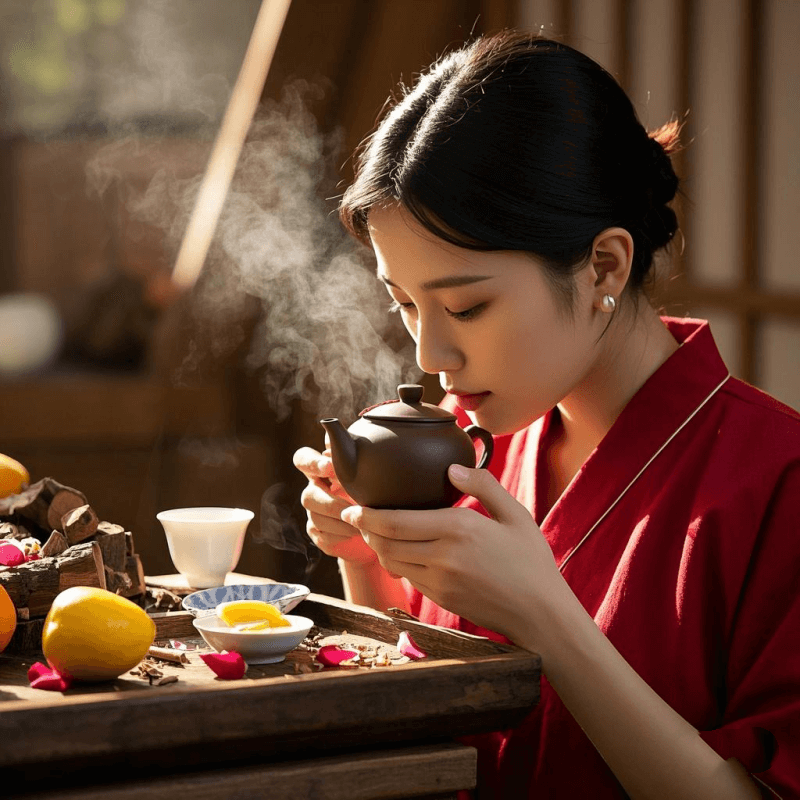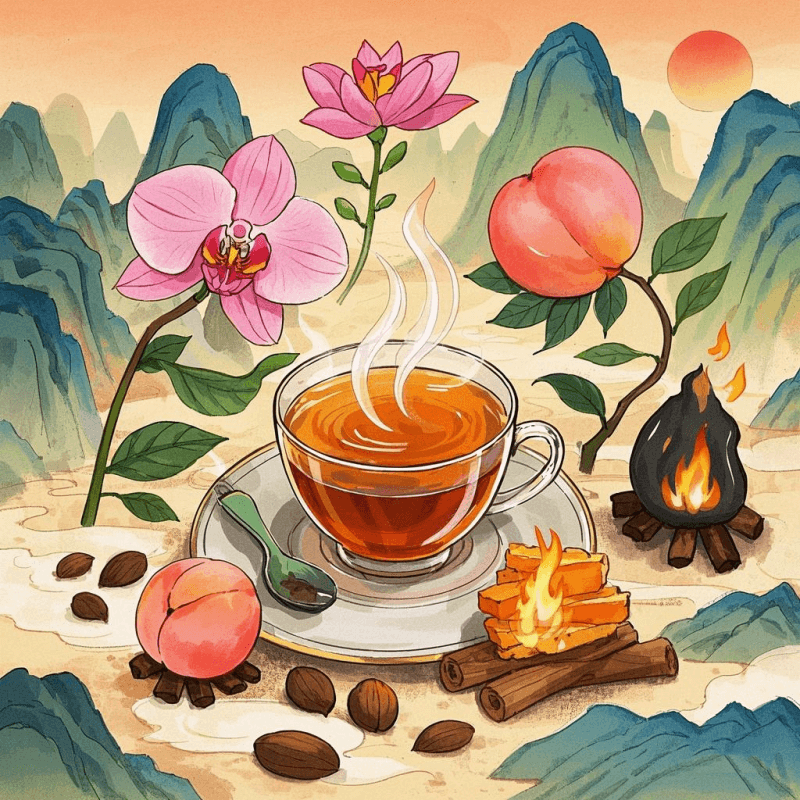
1. Introduction: Why China Oolong Tea’s Aroma Captivates the Senses
China oolong tea is more than a beverage—it’s an olfactory journey. A 2023 survey by TeaSource revealed that 89% of tea connoisseurs cite aroma as the primary reason they’re drawn to oolong tea, with china oolong tea standing out for its complex, layered scents. Unlike green tea’s grassy freshness or black tea’s malty richness, Chinese oolongs balance floral, fruity, and roasted notes, a result of meticulous craftsmanship and unique terroir. From the mist-shrouded mountains of Fujian to Taiwan’s high-altitude gardens, each region imparts a distinct aromatic fingerprint. This article explores the science, stories, and sensory joys of china oolong tea’s aroma, inviting you to discover why its scent alone can transform a simple sip into a memorable experience.
2. The Olfactory Palette: Core Aromatic Profiles of China Oolong Tea
China oolong tea’s aroma is a symphony of volatile compounds, developed through oxidation, firing, and regional microclimates. Here are the main scent families:
🌸 Floral Aromas: The Signature of Grace
- Orchid (Tie Guan Yin): Anxi’s traditional Tie Guan Yin is famed for its lan xiang (orchid fragrance), a delicate, heady scent that lingers on the palate. Chemical analysis shows linalool and geraniol—compounds also found in high-end perfumes—dominate this profile.
- Jasmine & Gardenia (Bai Hao Oolong): Taiwanese Bai Hao, or “Oriental Beauty,” combines oxidized leaf edges with natural insect-bitten sweetness, creating a bouquet of jasmine and overripe fruit.
🍑 Fruity Notes: Freshness in a Cup
- Green Apple & Pear (Alishan High Mountain): Grown above 1,000m in Taiwan, Alishan oolong’s cool climate fosters high levels of terpenoids, delivering crisp, juicy aromas reminiscent of just-peeled fruit.
- Stone Fruit & Tropical Exoticism (Phoenix Dan Cong): Guangdong’s Dan Cong teas, like “Mi Lan Xiang” (Honey Orchid), blend honeyed sweetness with notes of lychee and mango, a result of their unique single-bush cultivation.
🔥 Roasted & Woody Tones: Depth and Complexity
Toasted Nuts & Caramel (Roasted Tie Guan Yin): Modern Anxi roasts
Charred Cinnamon & Chestnut (Wuyi Rock Tea): Wuyi’s Da Hong Pao and Shui Xian undergo charcoal roasting, developing smoky, resinous aromas that pair with the “yan yun” (rock rhyme)—a mineral undertone from the region’s red sandstone soil.
🌸 Floral Aromas: The Signature of Grace
- Orchid (Tie Guan Yin): Anxi’s traditional Tie Guan Yin is famed for its lan xiang (orchid fragrance), a delicate, heady scent that lingers on the palate. Chemical analysis shows linalool and geraniol—compounds also found in high-end perfumes—dominate this profile.
- Jasmine & Gardenia (Bai Hao Oolong): Taiwanese Bai Hao, or “Oriental Beauty,” combines oxidized leaf edges with natural insect-bitten sweetness, creating a bouquet of jasmine and overripe fruit.
🍑 Fruity Notes: Freshness in a Cup
- Green Apple & Pear (Alishan High Mountain): Grown above 1,000m in Taiwan, Alishan oolong’s cool climate fosters high levels of terpenoids, delivering crisp, juicy aromas reminiscent of just-peeled fruit.
- Stone Fruit & Tropical Exoticism (Phoenix Dan Cong): Guangdong’s Dan Cong teas, like “Mi Lan Xiang” (Honey Orchid), blend honeyed sweetness with notes of lychee and mango, a result of their unique single-bush cultivation.
🔥 Roasted & Woody Tones: Depth and Complexity
- Charred Cinnamon & Chestnut (Wuyi Rock Tea): Wuyi’s Da Hong Pao and Shui Xian undergo charcoal roasting, developing smoky, resinous aromas that pair with the “yan yun” (rock rhyme)—a mineral undertone from the region’s red sandstone soil.
- Toasted Nuts & Caramel (Roasted Tie Guan Yin): Modern Anxi roasts add layers of hazelnut and brown sugar to the classic orchid base, appealing to those who crave depth alongside floral brightness.
As The Chinese Tea Journal notes, “The aroma of china oolong tea is a reflection of both nature and nurture—terroir provides the canvas, while artisans paint with fire and time.”

3. Famous Regions: How Terroir Shapes China Oolong Tea’s Aroma
🏔️ Fujian Province: The Cradle of Oolong Aroma
Wuyi Mountains (Wuyi Yancha)
- Aroma Style: Bold, resinous, with pronounced mineral notes.
- Secret of Terroir: The “99 Cliffs and 36 Creeks” create microclimates where tea bushes grow in crevices filled with weathered red soil, absorbing trace minerals that enhance the “rock rhyme.”
- Iconic Teas: Da Hong Pao (big red robe) – charred cinnamon and dried plum; Shui Xian – roasted chestnut and honeycomb.
Anxi County (Tie Guan Yin Homeland)
- Aroma Style: Pure floral elegance, with variations from creamy orchid (traditional) to toasted nut (roasted).
- Craftsmanship Impact: The “sha qing” (pan-firing) process halts oxidation at peak aroma development, preserving volatile compounds like benzyl alcohol, responsible for Tie Guan Yin’s signature scent.
- Must-Try: Traditional Tie Guan Yin – clean, orchid-forward; Roasted Tie Guan Yin – caramelized undertones with persistent fragrance.
🌌 Taiwan: Elevated Aromas from Cloud-Kissed Mountains
Ali Shan & Lishan (High Mountain Oolongs)
- Aroma Style: Fresh, floral, with citrus and green fruit notes.
- Altitude Effect: Cool temperatures (1,500–2,200m) slow leaf growth, increasing amino acid content (including L-theanine) that enhances both umami and aroma purity.
- User Review: “Pouring Alishan is like opening a basket of spring flowers—jasmine, lily, and a hint of ripe peach dance in the steam.” – Emma C., tea sommelier
Nantou & Pinglin (Jin Xuan & Bai Hao)
- Jin Xuan (Milk Oolong): Creamy, coconut-like aroma with a vegetal undertone, a natural result of the Jin Xuan cultivar’s high fatty acid content.
- Bai Hao (Oriental Beauty): Oxidized by tea jassids, it develops honeyed, tropical fruit aromas – a “wild, sweet perfume” according to Tea Journey Magazine.
4. Traditional Craftsmanship: The Art of Aroma Creation
China oolong tea’s aroma is a product of precise, labor-intensive steps:
1. Withering: The First Breath of Aroma
- Sun or shade withering reduces leaf moisture, activating enzymes that break down proteins into aromatic amino acids. Overwithering leads to dull scents; underwithering traps grassy notes.
2. Tossing (Zuo Qing): The Aroma Catalyst
- Artisans toss leaves in bamboo baskets to bruise edges, triggering oxidation. This “killing green” process releases volatile compounds—more tosses mean deeper oxidation and fruitier notes in Dan Cong, less for floral Tie Guan Yin.
3. Firing: Sealing in the Scent
- Pan-Firing (Sha Qing): Halts oxidation abruptly, preserving fresh floral notes in light oolongs.
- Charcoal Roasting (Yan Huo): Used for Wuyi teas, slow roasting over pine charcoal adds smoky, woody layers, while concentrating existing aromas into a cohesive bouquet.
As Master Tea Maker Chen Dehua explains, “Aroma is the soul of china oolong tea—we nurture it from leaf to cup, ensuring each step honors the plant’s natural gifts.”
5. Brewing to Unlock Aroma: Techniques for Maximum Scent Delivery
🍵 Gongfu Cha: The Aroma-Preserving Method
- Preheat Vessels: A warmed gaiwan or zisha pot retains heat, preventing aroma loss.
- Leaf-to-Water Ratio: 5–7g of tea in 150ml water for concentrated scent extraction.
- Steeping Precision:
- Light oolongs (Tie Guan Yin): 195°F (90°C), 15–20 seconds – preserves top notes.
- Roasted oolongs (Da Hong Pao): Boiling water (212°F), 25–30 seconds – releases deep, roasted aromas.
- Aroma Appreciation: Inhale the gaiwan lid after each steep; the first steep’s aroma is bright and primary, while later steeps reveal secondary notes like spice or honey.
🧊 Cold Brewing: A Different Aroma Profile
- Steep 8g of tea in 500ml cold water for 6–8 hours. Cold extraction emphasizes sweet, fruity aromas (perfect for Alishan or Jin Xuan), with reduced astringency.
6. User Stories: How Drinkers Describe China Oolong Tea’s Aroma
- “Like walking through a mountain orchid garden after rain—clean, vibrant, with a dew-kissed sweetness.” – Li Wei, Beijing tea enthusiast (on Anxi Tie Guan Yin)
- “Da Hong Pao smells like an old library and a campfire had a baby—smoky, woody, with a hidden floral heart.” – Sarah M., Seattle-based blogger
- “Bai Hao’s aroma is tropical vacation in a cup—lychee, mango, and a hint of honeyed jasmine that lingers for minutes.” – Amina K., Dubai tea sommelier
7. Conclusion: Every Cup of China Oolong Tea is an Aromatic Adventure
From the floral elegance of Anxi to the roasted grandeur of Wuyi, china oolong tea’s aroma is a testament to nature’s diversity and human craftsmanship. Each region, each tea, offers a unique scent story—one that engages the senses, sparks curiosity, and invites repeated exploration. Whether you’re drawn to the delicate orchid notes of Tie Guan Yin or the bold, smoky layers of Da Hong Pao, the aroma of oolong tea transcends taste, creating moments of pure sensory joy.
Ready to embark on your own aromatic journey? Explore our collection of china oolong tea from heritage-rich regions and discover how each sip carries the essence of mountains, seasons, and centuries of tea-making art. Let the aroma guide you—after all, in the world of china oolong tea, scent is the first step to falling in love.
Discover the captivating aroma of china oolong tea from famous regions! Explore how terroir and craft shape floral, fruity, and roasted notes. Elevate your tea experience—click to explore oolong tea’s aromatic magic!
